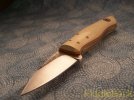- Joined
- Aug 13, 2002
- Messages
- 5,703
I got to get me one of those Fred.:thumbup:
This is turning out to be a very good thread. Thanks again for all your input.
I just want to make sure that all the tips don't scare new makers. It's not really that complicated but it's like many things. You can read a zillion pages about it but it's when you actually DO IT that all it comes together and that the explanations make more sense.
So you don't even need a blade. Take a block of cheap pine, chuck it in the vise and put all those tips in practice by shaping a handle on the part sticking out.
It'll give you confidence to do the same with that nice block of presentation quality Thuya burl you sold one of your kidney for.
This is turning out to be a very good thread. Thanks again for all your input.
I just want to make sure that all the tips don't scare new makers. It's not really that complicated but it's like many things. You can read a zillion pages about it but it's when you actually DO IT that all it comes together and that the explanations make more sense.
So you don't even need a blade. Take a block of cheap pine, chuck it in the vise and put all those tips in practice by shaping a handle on the part sticking out.
It'll give you confidence to do the same with that nice block of presentation quality Thuya burl you sold one of your kidney for.








